Vibration Serviceability of Footbridges: Classical vs. Innovative Material Solutions for Deck Slabs
Abstract
:1. Introduction
2. Materials and Methods
2.1. Risk of Resonance and Comfort Criteria Assessment for Footbridges
2.2. Dynamic Loading Generated during Human Movement
2.3. Structural Layouts and FE (finite element) Models of the Footbridges with Traditional RC Slabs
2.3.1. Geometry and Material Data of the Three-Span Cable-Stayed Footbridge
2.3.2. Geometry and Material Data of the Three-Span Continuous Beam Footbridge
2.4. Structural Layouts and FE Models of the Footbridges with Innovative GFRP Slabs
3. Results
3.1. Natural Frequencies and Modes of Vibration of the Footbridges
3.2. The Strategy of Pacing Frequency Selection of a Single Pedestrian Moving
3.3. Damping Ratios Adopted for the Footbridges with the RC and GFRP Slabs
3.4. Vibration Performance of the Cable-stayed Footbridge
3.4.1. The Cable-stayed Footbridge Exposed to a Single Pedestrian Walking
3.4.2. The Cable-stayed Footbridge Exposed to a Single Pedestrian Running
3.5. Vibration Performance of the Beam Footbridge
3.5.1. The Beam Footbridge Exposed to a Single Pedestrian Walking
3.5.2. The Beam Footbridge Exposed to a Single Pedestrian Running
4. Discussion—Traditional RC vs. Innovative GFRP Deck Slab
4.1. Risk of Resonance Levels
4.2. Vibration Serviceability and Comfort Criteria Assessment of the Footbridges
4.3. Impact of Higher Harmonics of a Human-induced Force on the Dynamic Performance of the Footbridges
5. Conclusions
- The footbridges, both cable-stayed and beam, benefitted with GFRP slabs had higher fundamental frequency than those with traditional RC slabs. Such a phenomenon occurred due to the fact that the mass decrease in the structures with GFRP slabs was larger than the decrease in their stiffness in comparison with the traditional bridges of identical geometry. The footbridges equipped with the GFRP slabs were less exposed to the risk of resonance than those with the RC slabs, as they had fundamental frequencies shifted up, beyond the ranges of the high risk of resonance. The effect of shifting up the natural frequencies by introducing GFRP slabs was more remarkable in the case of the lightweight beam structure than for the cable-stayed footbridge and resulted in a significant reduction of the resonance risk.
- The calculated maximum accelerations of the footbridges benefitted with the GFRP slabs executed by a single pedestrian moving were meaningfully higher than those obtained for the footbridges with the classical RC slabs. Therefore, meeting vibration serviceability and comfort criteria limits may be more challenging for the footbridges with the GFRP slabs. The study also proved that meeting vibration serviceability and comfort criteria limits in case of very lightweight beam structures with GFRP slabs may be more problematic than for cable-stayed footbridges with GFRP slabs, having more massive structural systems.
- In the case of footbridges, both cable-stayed and beam, equipped with the RC slabs the higher harmonics of the human force did not play any role in the dynamic performance of structures. However, in the case of the footbridges benefitted with the GFRP slabs, the impact of higher harmonics of the pedestrian force on the dynamic behavior of structures was clearly visible. Higher harmonics excited accelerations of amplitudes comparable to those executed by first harmonic component.
Author Contributions
Funding
Conflicts of Interest
References
- Smits, J. Fiber-Reinforced Polymer Bridge Design in the Netherlands: Architectural Challenges toward Innovative, Sustainable, and Durable Bridges. Engineering 2016, 2, 518–527. [Google Scholar] [CrossRef]
- Li, Y.-F.; Badjie, S.; Chen, W.; Chiu, Y.-T. Case study of first all-GFRP pedestrian bridge in Taiwan. Case Stud. Constr. Mater. 2014, 1, 83–95. [Google Scholar] [CrossRef] [Green Version]
- Bachmann, H. “Lively” footbridges-a real challenge. In Proceedings of the International Conference on the Design and Dynamic Behaviour of Footbridges, Paris, France, 20–22 November 2002. [Google Scholar]
- Ascione, L.; Caron, J.-F.; Godonou, P.; Van Ijselmuijden, K.; Knippers, J.; Mottram, T.; Oppe, M.; Sorensen, M.G.; Taby, J.; Tromp, L.; et al. Prospect for New Guidance in the Design of FRP; Publications Office of the European Union: Ispra, Italy, 2016. [Google Scholar]
- American Composites Manufacturers Association (ACMA). Pre-Standard for Load and Resistance Factor Design (LRFD) of Pultruded Fiber Reinforced Polymer (FRP) Structures; American Society of Civil Engineers: Reston, VA, USA, 2010. [Google Scholar]
- AASHTO. LRFD Guide Specifications for Design of FRP Pedestrian Bridges, 2nd ed.; American Association of State Highway and Transportation Officials: Washington, DC, USA, 2009. [Google Scholar]
- Department for Transport. Design of FRP Bridges and Highway Structures. Design Manual for Roads and Bridges; Section 3, Part 17, BD 90/05; Department for Transport: London, UK, 2005; Volume 1.
- Wei, X.; Russell, J.; Živanović, S.; Mottram, J.T. Measured dynamic properties for FRP footbridges and their critical comparison against structures made of conventional construction materials. Compos Struct. 2019, 223, 110956. [Google Scholar] [CrossRef]
- Qiao, P.; Davalos, J.; Brown, B. A systematic analysis and design approach for single-span FRP deck/stringer bridges. Compos. Part B: Eng. 2000, 31, 593–609. [Google Scholar] [CrossRef]
- Luke, S.; Canning, L.; Collins, S.; Knudsen, E.; Brown, P.; Taljsten, B.; Olofsson, I. The development of an advanced composite bridge decking system–Project ASSET. Struct. Eng. Int. 2002, 12, 76–79. [Google Scholar] [CrossRef]
- Keller, T. Use of Fibre Reinforced Polymers in Bridge Construction; Structural Engineering Documents. No. 7; IABSE: Zurich, Switzerland, 2003. [Google Scholar]
- Moon, D.Y.; Zi, G.; Lee, D.H.; Kim, B.M.; Hwang, Y.K. Fiber reinforced plastic deck profile for i-girder bridges. Compos. Struct. 2005, 67, 411–416. [Google Scholar]
- Park, K.T.; Hwang, Y.K.; Lee, Y.H.; Kim, S.M. Performance verification of a new pultruded GFRP bridge deck-to-girder connection system. Compos. Struct. 2007, 81, 114–124. [Google Scholar] [CrossRef]
- Lee, S.W.; Hong, K.J.; Park, S. Current and future applications of glass-fibre-reinforced polymer decks in Korea. Struct. Eng. 2010, 20, 405–408. [Google Scholar] [CrossRef]
- Sutherland, L.S.; Sá, M.F.; Correia, J.R.; Guedes Soares, C.; Gomes, A.; Silvestre, N. Quasistatic indentation response of pedestrian bridge multicellular pultruded GFRP deck panels. Constr. Build. Mater. 2016, 118, 307–318. [Google Scholar] [CrossRef]
- Richardson, M.O.W.; Wisheart, M.J. Review of low velocity impact properties of composite materials. Compos. A Appl. Sci. Manuf. 1996, 27, 1123–1131. [Google Scholar] [CrossRef]
- Sutherland, L.S.; Sá, M.F.; Correia, J.R.; Guedes Soares, C.; Gomes, A.; Silvestre, N. Impact response of pedestrian bridge multicellular pultruded GFRP deck panels. Compos. Struct. 2017, 171, 473–485. [Google Scholar] [CrossRef]
- Živanović, S.; Wei, X.; Russell, J.; Mottram, J.T. Vibration performance of two FRP footbridge structures in the United Kingdom. In Proceedings of the Footbridge 2017, Berlin, Germany, 6–8 September 2017. [Google Scholar]
- Stankiewicz, B. Bridge structures with GFRP composite deck. Open J. Civ. Eng. 2015, 5, 53–62. [Google Scholar] [CrossRef] [Green Version]
- Junges, P.; Rovere, H.L.L.; Pinto, R.C.A. Vibration Analysis of a Composite Concrete/GFRP Slab Induced by Human Activities. J. Compos. Sci. 2017, 1, 11. [Google Scholar] [CrossRef] [Green Version]
- SÉTRA 2006: Assessment of Vibrational Behaviour of Footbridges under Pedestrian Loading. Technical Guide; Technical Department for Transport, Roads and Bridges Engineering and Road Safety: Paris, France, 2006.
- British Standard Institution. Steel, Concrete and Composite Bridges-Part 2: Specification for Loads; Appendix C: Vibration Serviceability Requirements for Foot and Cycle Track Bridges, BS5400; BSI: London, UK, 1978. [Google Scholar]
- International Organization for Standardization. Bases for Design Structures-Serviceability of Buildings and Walkways Against Vibration; ISO 10137.2; International Organization for Standardization: Geneva, Switzerland, 2007. [Google Scholar]
- 1990:2002/Al (2005) Eurocode—Basis of Structural Design; CEN: Brussels, Belgium, 2005.
- Bachmann, H.; Ammann, W. Vibrations in Structures—Induced by Man and Machines; Structural Engineering Documents; International Association of Bridge and Structural Engineering (IABSE): Zürich, Switzerland, 1987. [Google Scholar]
- Van Nimmen, K.; Lombaert, G.; De Roeck, G.; Van den Broeck, P. Vibration serviceability of footbridges: Evaluation of the current codes of practice. Eng. Struct. 2014, 59, 448–461. [Google Scholar] [CrossRef]
- Occhiuzzi, A.; Spizzuoco, M.; Ricciardelli, F. Loading models and response control of footbridges excited by running pedestrians. Struct. Control Health Monit. 2008, 15, 349–368. [Google Scholar] [CrossRef]
- Marecik, K.; Pańtak, M. A comparative analysis of selected models of pedestrian-generated dynamic loads on footbridges-vertical loads. MATEC Web Conf. 2018, 222, 01009. [Google Scholar] [CrossRef]
- Pańtak, M. Ground Reaction Forces Generated by Runners—Harmonic Analyses and Modelling. Appl. Sci. 2020, 10, 1575. [Google Scholar] [CrossRef] [Green Version]
- Zivanovic, S.; Pavic, A.; Reynolds, P. Vibration serviceability of footbridges under human-induced excitation: A literature review. J. Sound Vib. 2005, 279, 1–74. [Google Scholar] [CrossRef] [Green Version]
- Flaga, A. Footbridges; WKŁ: Warsaw, Poland, 2011. (In Polish) [Google Scholar]
- Drygala, I.J.; Polak, M.A.; Dulinska, J.M. The dynamic evaluation of composite materials footbridges. In Proceedings of the 39th IABSE Symposium, Vancouver, IABSE c/o ETH Hönggerberg, Zürich, Switzerland, 21–23 September 2017; pp. 2285–2292. [Google Scholar]
- Bachmann, H.; Ammann, W.; Deischl, F.; Eisenmann, J.; Floegl, I.; Hirsch, G.H.; Klein, G.K.; Lande, G.J.; Mahrenholtz, O.; Natke, H.G.; et al. Vibration Problems in Structures: Practical Guideline; Birkhäuser Verlag: Basel, Switzerland, 1995. [Google Scholar]
- Bachmann, H.; Pretlove, A.J.; Rainer, H. Dynamic forces from rhythmical human body motions. In Vibration Problems in Structures: Practical Guidelines; Birkhäuser: Basel, Switzerland, 1995; Appendix G. [Google Scholar]
- Drygala, I.J.; Polak, M.A.; Dulinska, J.M. Vibration serviceability assessment of GFRP pedestrian bridges. Eng. Struct. 2019, 184, 176–185. [Google Scholar] [CrossRef]
- Polish Committee for Standardization: The Bridge Structures, Loads (PN-85/S-10030); Polish Committee for Standardization: Warsaw, Poland, 1985. (In Polish)
- Simulia ABAQUS. 2013. Users’ Manual Version 6.13 Documentation; c2013–2015; Dassault Systemes: Velizy-Villacoublay, France, 2015. [Google Scholar]
- Buckle, I.; Nagarajaiah, S.; Ferrell, K. Stability of Elastomeric Isolation Bearings: Experimental Study. J. Struct. Eng. 2002, 128, 3–11. [Google Scholar] [CrossRef]
- Manalo, A.; Aravinthan, T.; Fam, A.; Benmokrane, B. State-of-the-Art Review on FRP Sandwich Systems for Lightweight Civil Infrastructure. J. Compos. Constr. 2017, 21, 04016068. [Google Scholar] [CrossRef] [Green Version]
- Huo, R.; Liu, W.; Wan, L.; Fang, Y.; Wang, L. Experimental Study on Sandwich Bridge Decks with GFRP Face Sheets and a Foam-Web Core Loaded under Two-Way Bending. Adv. Mater. Sci. Eng. 2015, 2015, 1–12. [Google Scholar] [CrossRef] [Green Version]
- Herakovich, C.T. Mechanics of Fibrous Composites; Wiley: New York, NY, USA, 1998. [Google Scholar]
- Chróścielewski, J.; Kreja, I.; Sabik, A.; Sobczyk, B.; Witkowski, W. Failure analysis of footbridge made of composite materials. In Shell Structures: Theory and Applications; Pietraszkiewicz, W., Górski, J., Eds.; CRC Press. Taylor & Francis Group: London, UK, 2014; pp. 389–392. [Google Scholar]
- Chróścielewski, J.; Klasztorny, M.; Nycz, D.; Sobczyk, B. Load capacity and serviceability conditions for footbridges made of fibre-reinforced polymer laminates. Roads Bridges 2014, 13, 189–202. [Google Scholar]
- Chróścielewski, J.; Miśkiewicz, M.; Pyrzowski, Ł.; Sobczyk, B.; Wilde, W. A novel sandwich footbridge-Practical application of laminated composites in bridge design and in situ measurements of static response. Compos. Part B-Eng. 2017, 126, 153–161. [Google Scholar] [CrossRef]
- Wazowski, M. Report on the static and dynamic test load of a footbridge over national road No. 7 in the town of Głogoczow (L.17-048-W), Jaworzno, Poland. Procedia Eng. 2017. [Google Scholar]
- Wei, X.; Russell, J.; Živanović, S.; Mottram, J.T. Experimental investigation of the dynamic characteristics of a glass-FRP suspension footbridge. In Proceedings of the 35th IMAC, A Conference and Exposition on Structural Dynamics, Garden Grove, CA, USA, 30 January–2 February 2017; Springer International Publishing: Cham, Switzerland, 2017; pp. 37–47. [Google Scholar]
- Votsis, R.A.; Stratford, T.J.; Chyssanthopoulos, M.K. Dynamic assessment of a FRP suspension footbridge. In Proceedings of the 4th International Conference on Advanced Composites in Construction, Edinburgh, UK, 1–3 September 2009. [Google Scholar]
- Živanović, S.; Feltrin, G.; Mottram, J.T.; Brownjohn, J.M.W. Vibration Performance of Bridges Made of Fiber Reinforced Polymer. In Proceedings of the Conference: IMAC-XXXII, Orlando, FL, USA, 3–6 February 2014. [Google Scholar]
- Matsumoto, Y.; Nishioka, T.; Shiojiri, H.; Matsuzaki, K. Dynamic design of footbridges. IABSE Proceedings, No. P-17/78. Zürich, Switzerland; 1978; pp. 1–15. [Google Scholar]
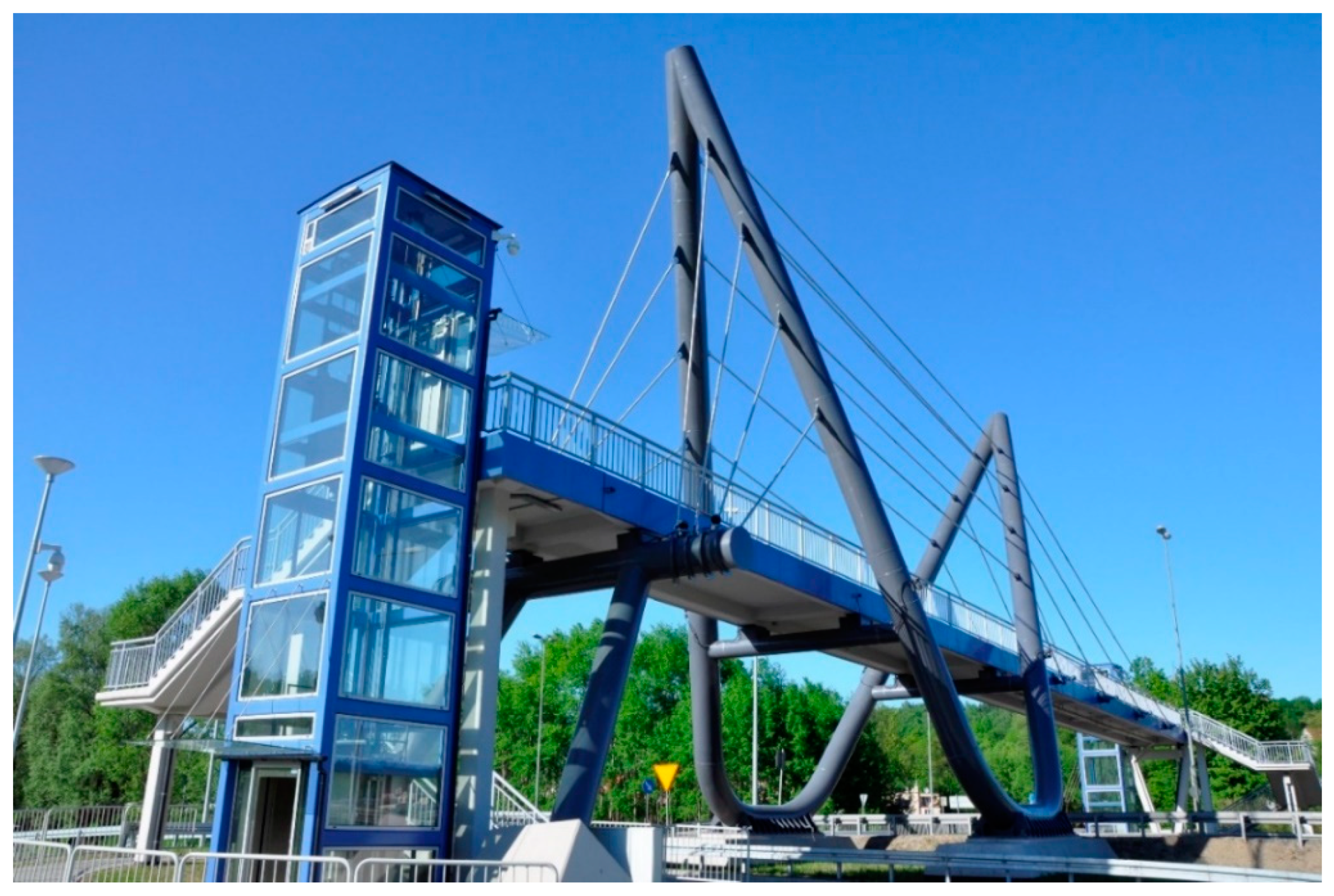
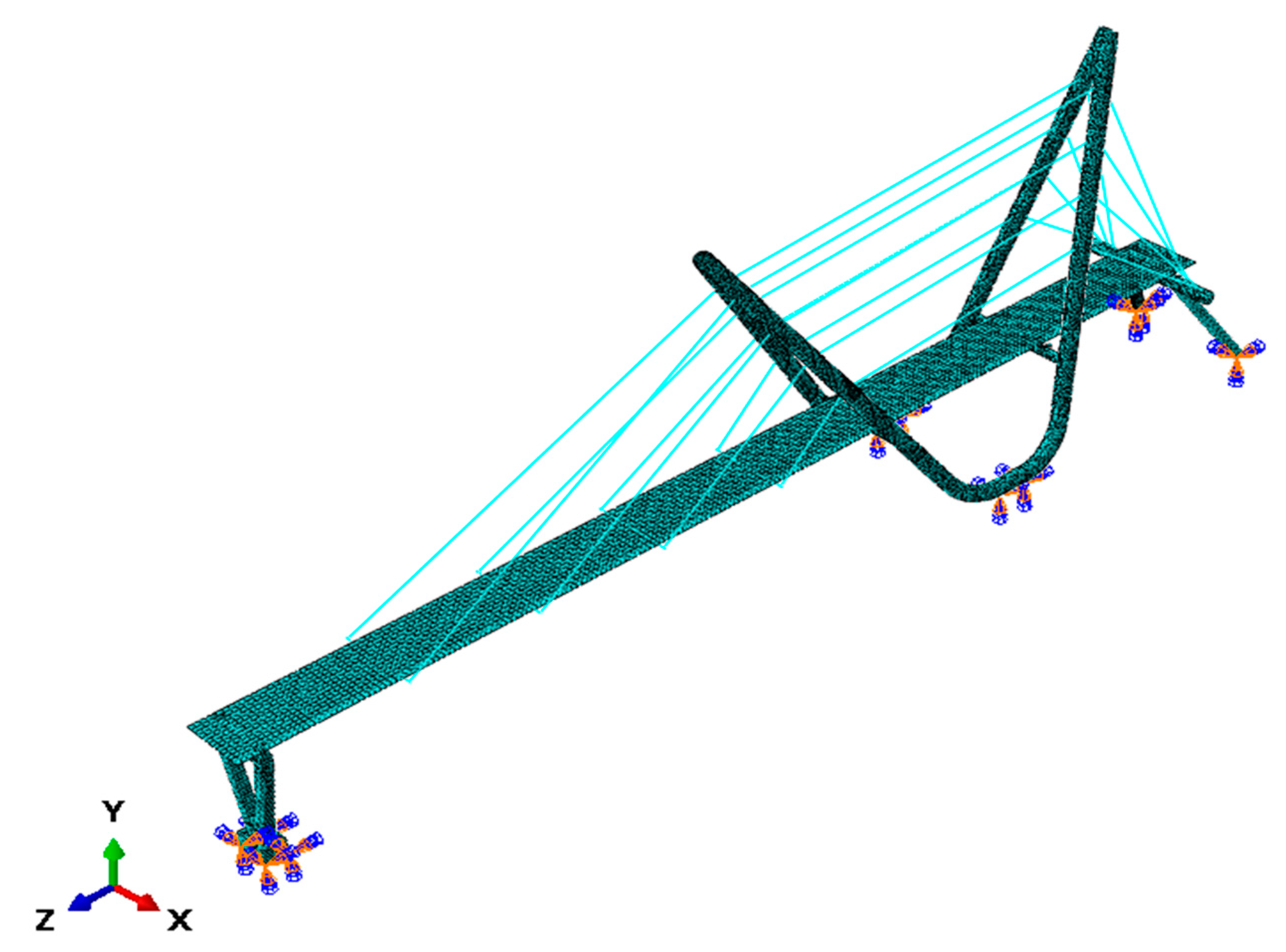
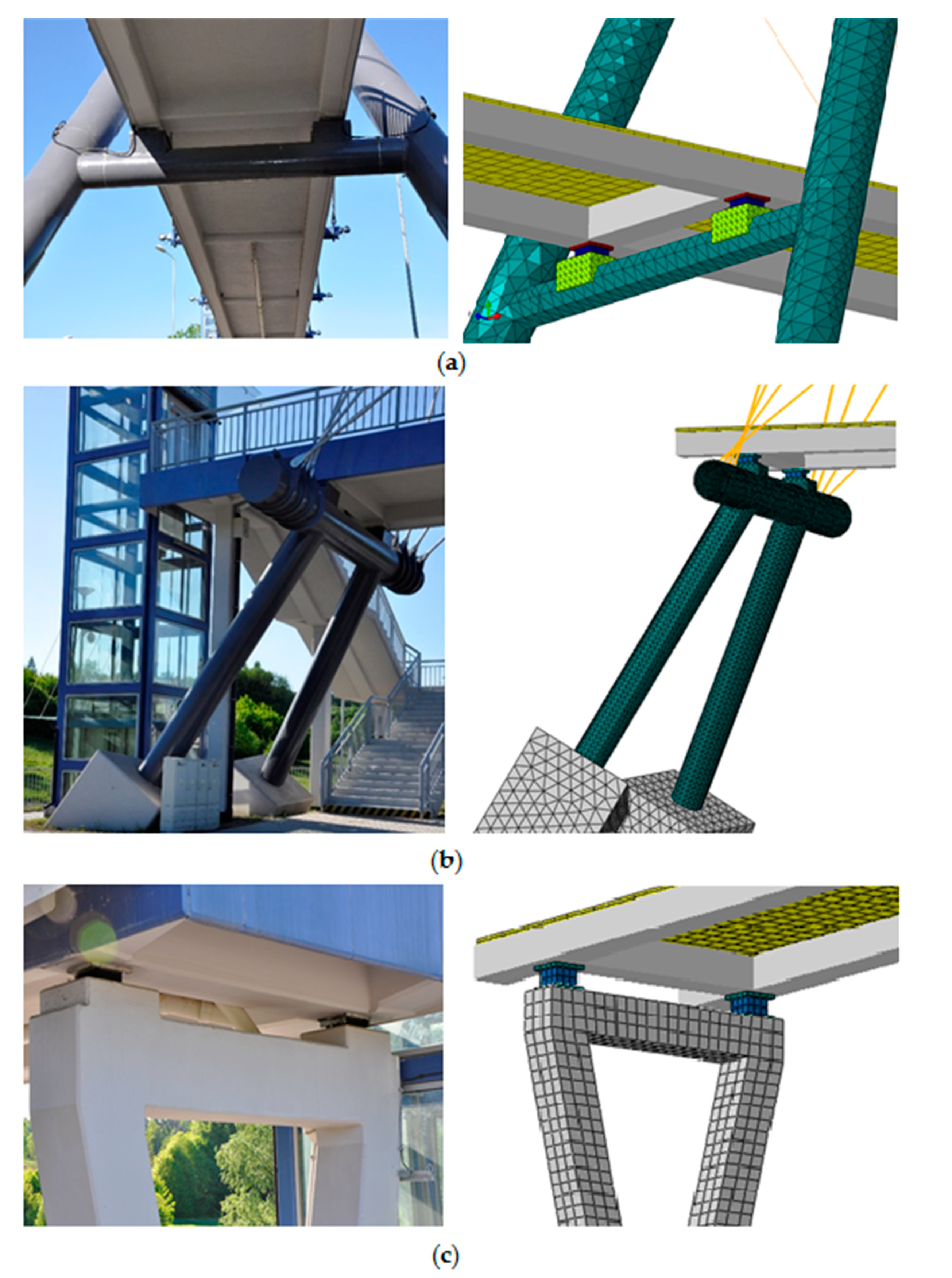
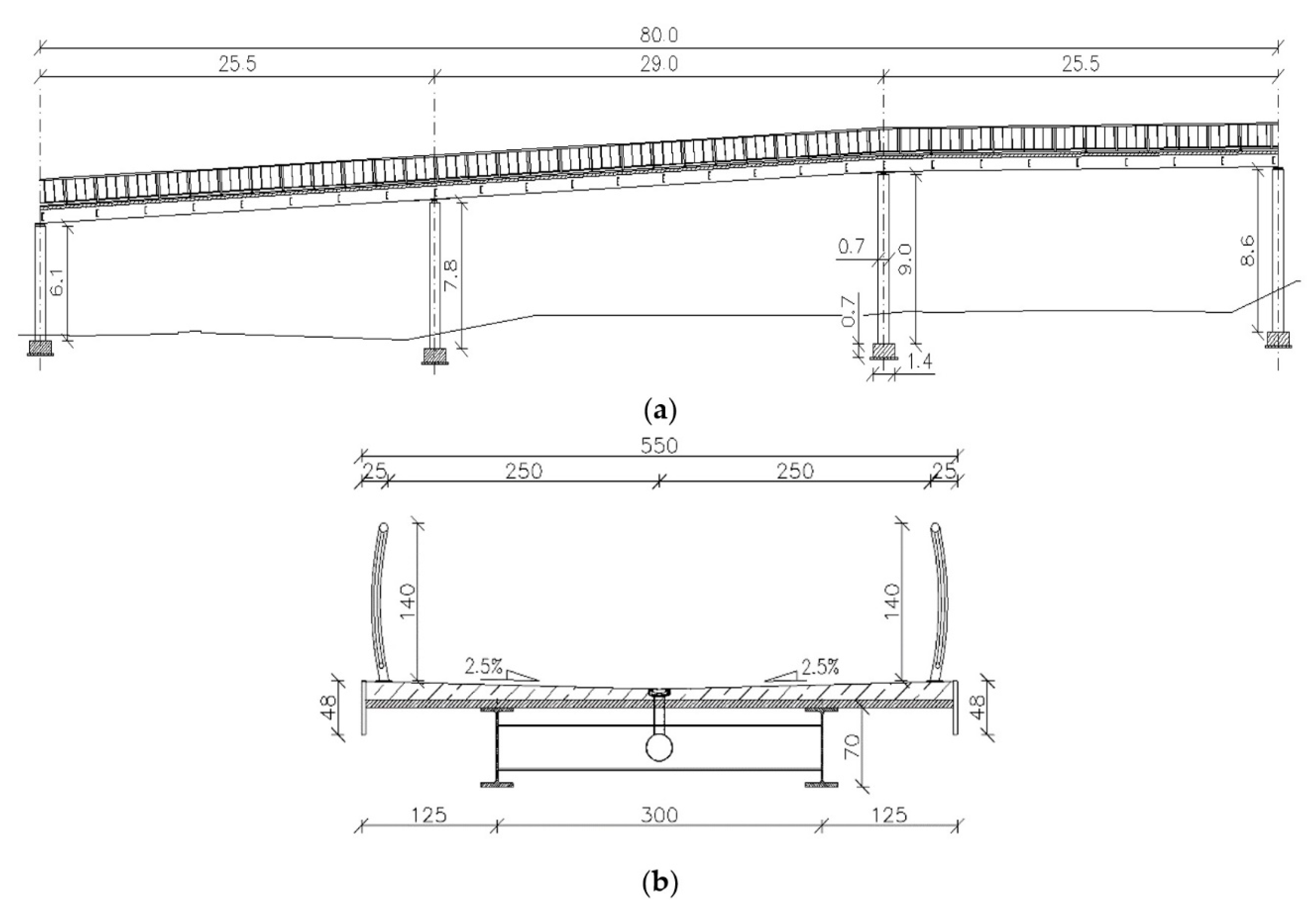
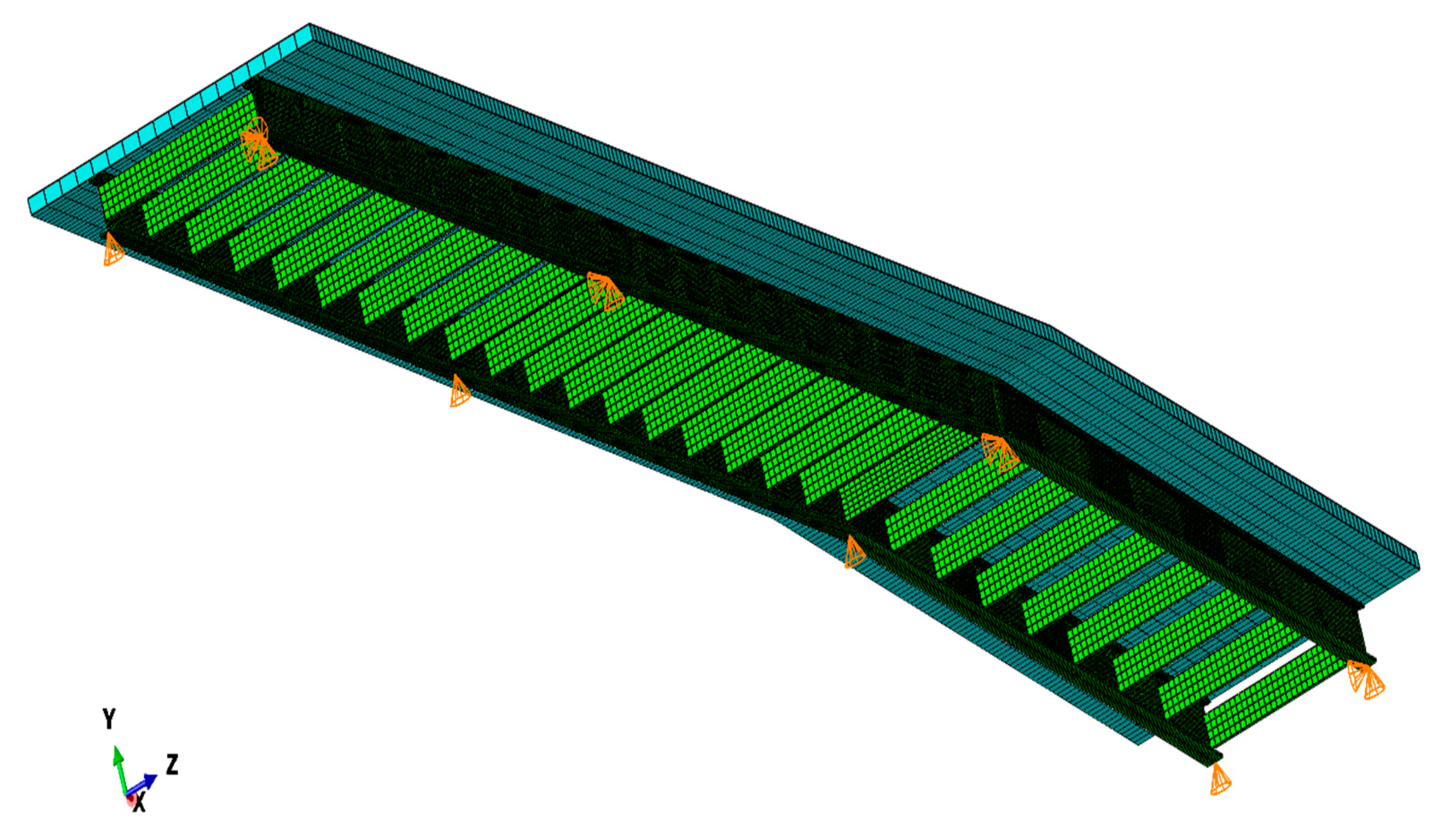

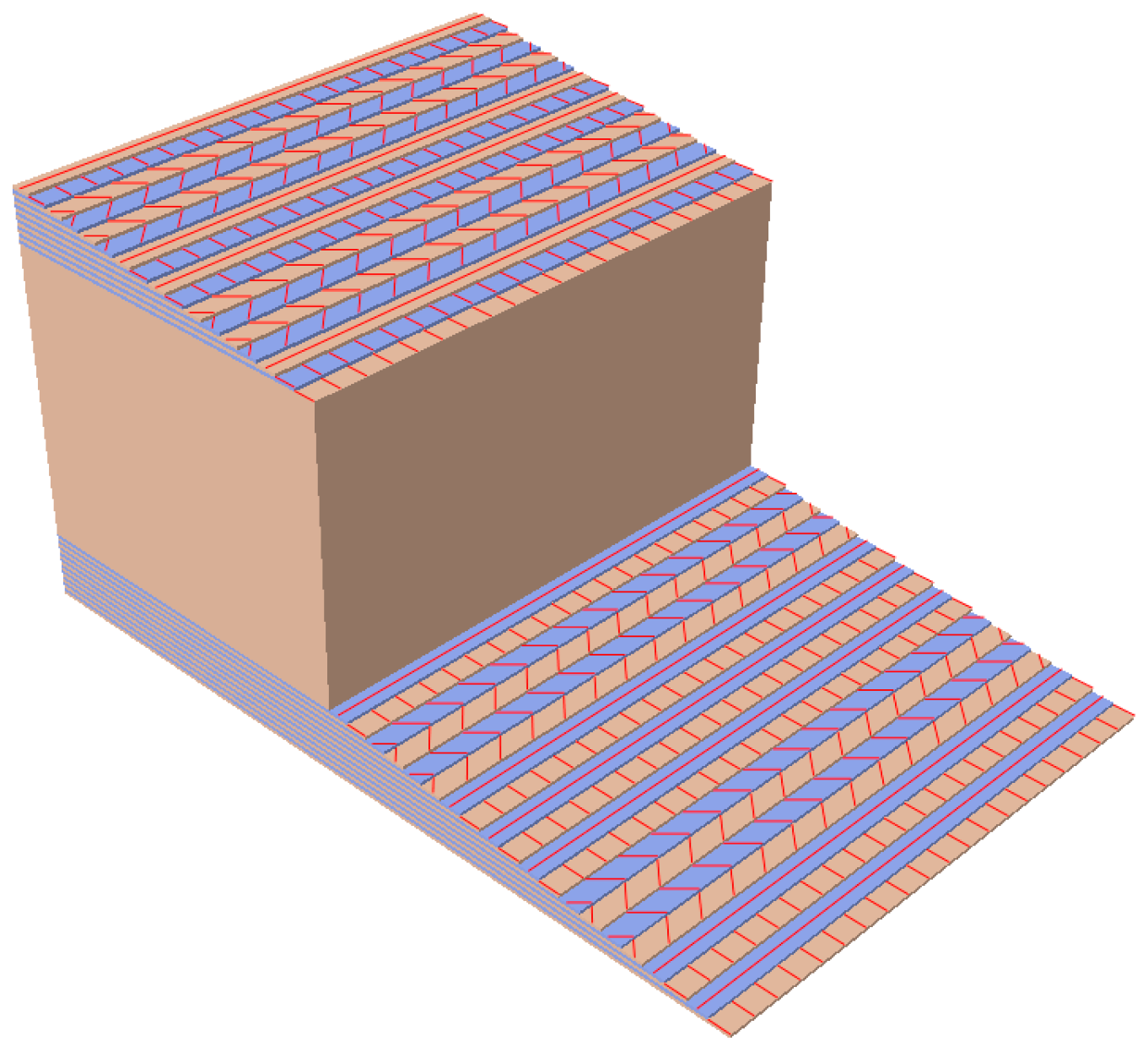
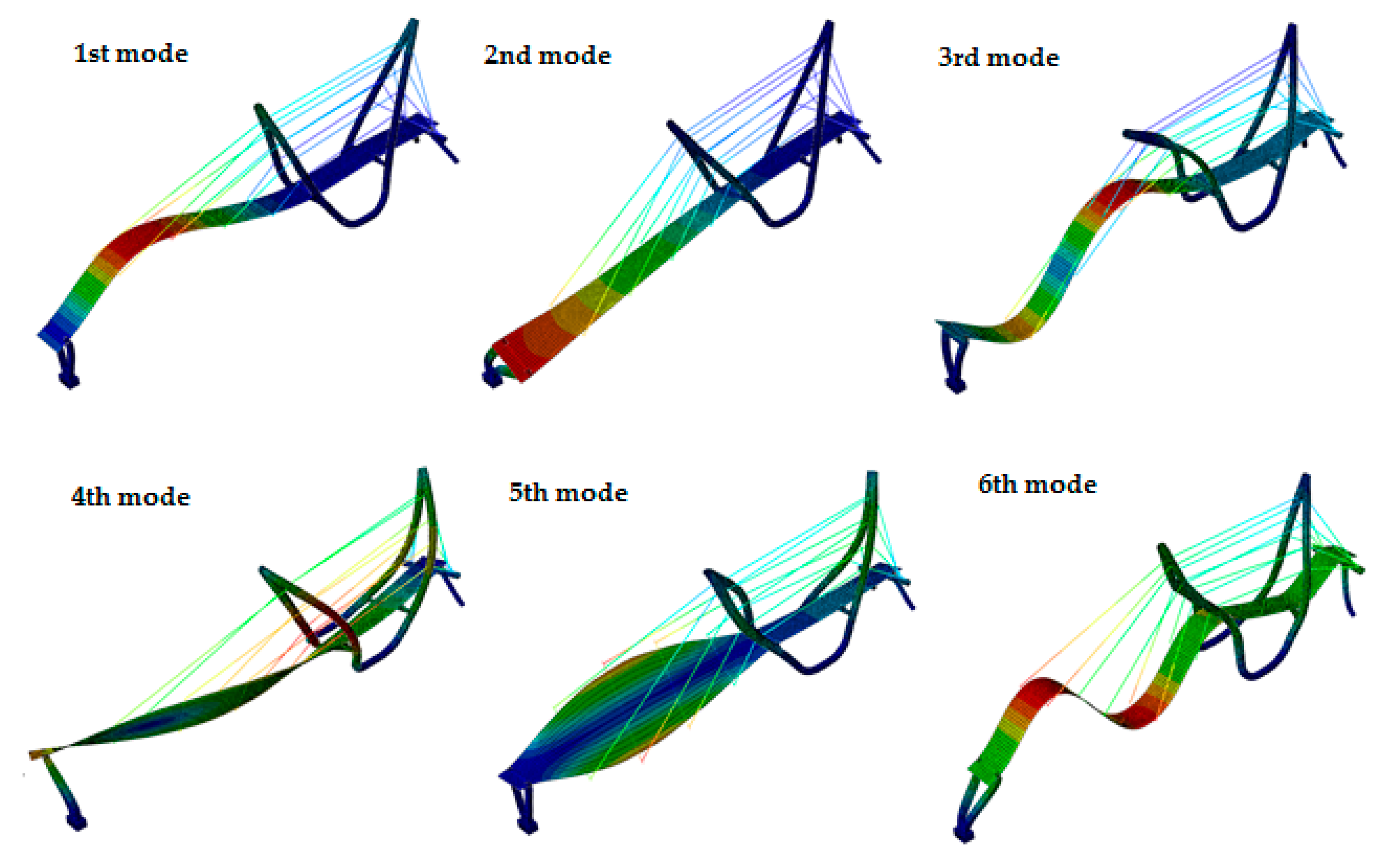
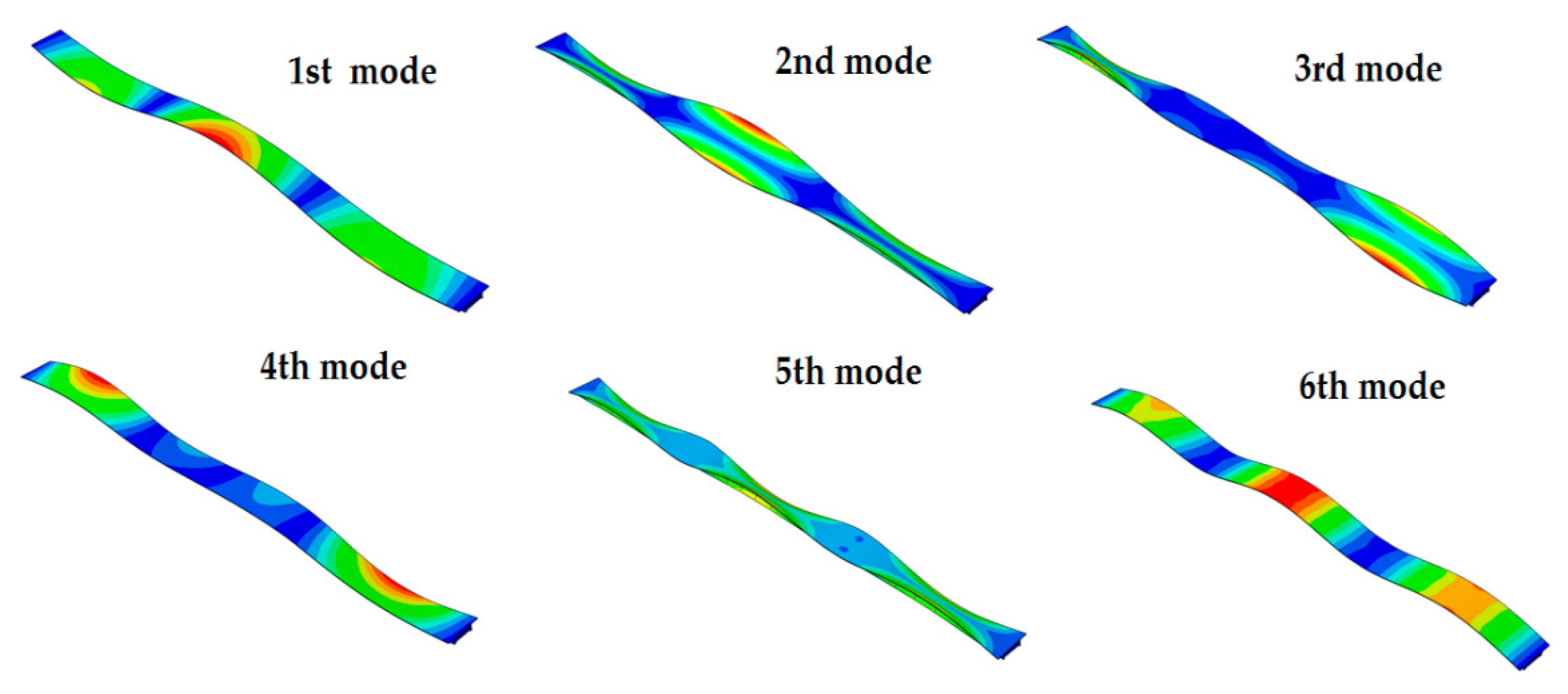


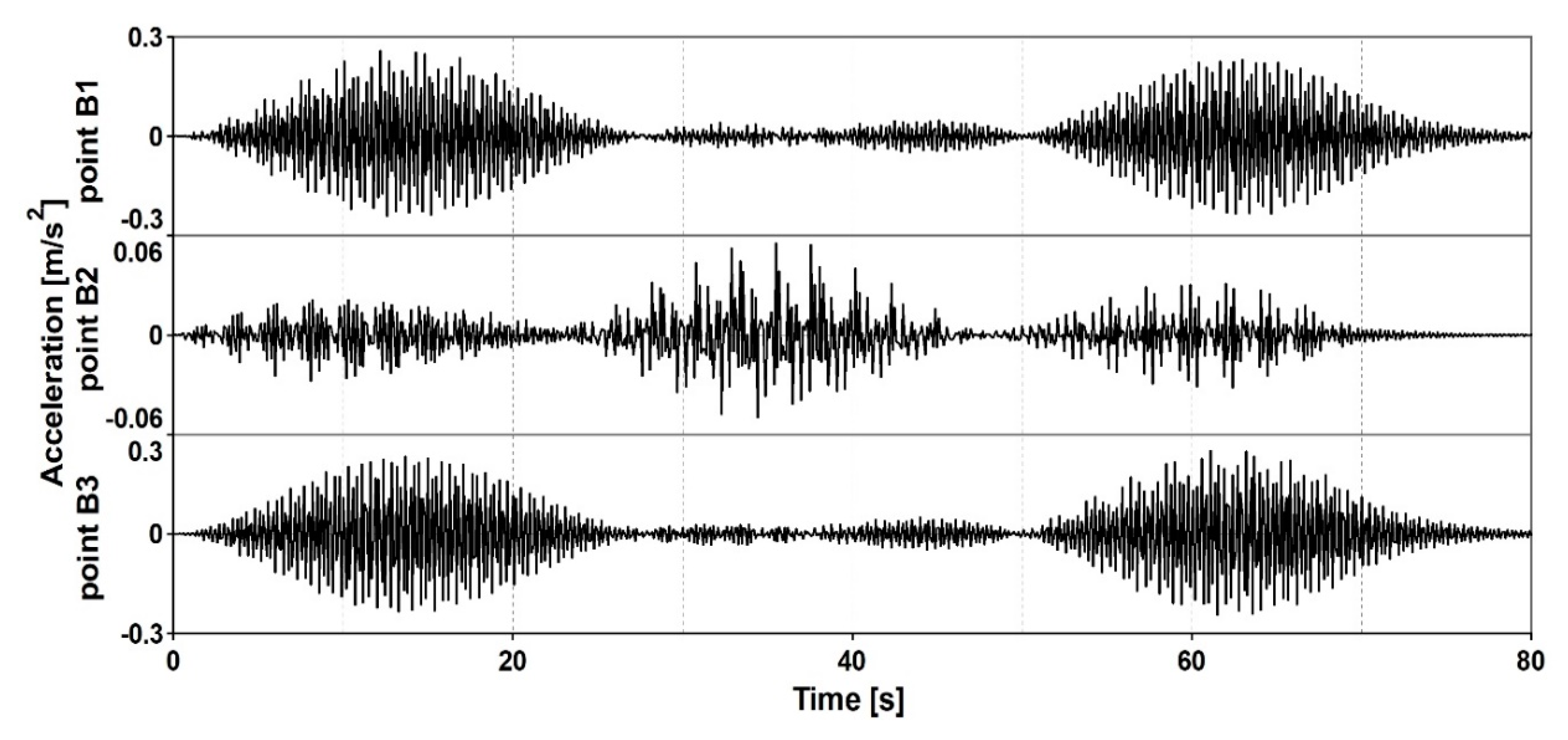
| Risk of Resonance | Frequency Ranges [Hz] | |
|---|---|---|
| Vertical | Horizontal | |
| maximum | 1.7–2.1 | 0.5–1.1 |
| medium | 1.0–1.7; 2.1–2.6 | 0.3–0.5; 1.1–1.3 |
| low | 2.6–5.0 | 1.3–2.5 |
| negligible | 0–1.0; >5.0 | 0–0.3; >5.0 |
| Comfort Level | Ranges of Comfort [m/s2] | |
|---|---|---|
| Vertical | Horizontal | |
| maximum | 0.0–0.5 | 0.00–0.15 |
| mean | 0.5–1.0 | 0.15–0.30 |
| minimum | 1.0–2.5 | 0.30–0.80 |
| uncomfortable | >2.5 | >0.8 |
| Type of Movement | The Range of Frequencies [Hz] | |||
|---|---|---|---|---|
| Total | Slow | Normal | Fast | |
| walking | 1.4–2.4 | 1.4–1.7 | 1.7–2.2 | 2.2–2.4 |
| running | 1.9–3.3 | 1.9–2.2 | 2.2–2.7 | 2.7–3.3 |
| Upper Sandwich GFRP Layer, 14 mm Thick | ||||||||||||||||||||
|---|---|---|---|---|---|---|---|---|---|---|---|---|---|---|---|---|---|---|---|---|
| No. of ply | 1 | 2 | 3 | 4 | 5 | 6 | 7 | 8 | 9 | 10 | 11 | 12 | 13 | 14 | 15 | 16 | 17 | 18 | 19 | 20 |
| Rotation angle [°] | 0 | 90 | 0 | 90 | −45 | 45 | −45 | 45 | 0 | 90 | 0 | 90 | 0 | 90 | −45 | 45 | −45 | 45 | 0 | 90 |
| Inner Sandwich FOAM Layer, 62.4 mm Thick | ||||||||||||||||||||
| No. of ply | 1 | |||||||||||||||||||
| Rotation angle [°] | 0 | |||||||||||||||||||
| Bottom Sandwich GFRP Layer, 11.2 mm Thick | ||||||||||||||||||||
| No. of ply | 1 | 2 | 3 | 4 | 5 | 6 | 7 | 8 | 9 | 10 | 11 | 12 | 13 | 14 | 15 | 16 | ||||
| Rotation angle [°] | 0 | 90 | −45 | 45 | −45 | 45 | 0 | 90 | 0 | 90 | −45 | 45 | −45 | 45 | 0 | 90 | ||||
| Footbridge | Slab Variant | Natural Frequency [Hz] Corresponding to: | ||
|---|---|---|---|---|
| 1st Vertical Mode | 2nd Vertical Mode | 3rd Vertical Mode | ||
| Cable-stayed | RC | 2.40 | 4.45 | 5.61 |
| GFRP | 3.45 | 6.17 | 7.53 | |
| Beam | RC | 2.00 | 2.73 | 7.78 |
| GFRP | 2.76 | 3.83 | 4.91 | |
| Point | Maximum Accelerations [m/s2] at Frequency: | |||
|---|---|---|---|---|
| 2.4 Hz Fast Walking 1st Natural Frequency | 2.23 Hz 2nd Harmonics Excites 2nd Mode | 1.48 Hz 3rd Harmonics Excites 2nd Mode | 1.87 Hz 3rd Harmonics Excites 3rd Mode | |
| CS1 | 0.09 | 0.06 | 0.08 | 0.04 |
| CS2 | 0.10 | 0.06 | 0.07 | 0.03 |
| CS3 | 0.14 | 0.06 | 0.08 | 0.03 |
| CS4 | 0.15 | 0.05 | 0.05 | 0.03 |
| Point | Maximum Accelerations [m/s2] at Frequency: | ||
|---|---|---|---|
| 2.4 Hz Fast Walking | 1.73 Hz 2nd Harmonics Excites 1st Vertical Mode | 2.06 Hz 3rd Harmonics Excites 2nd Vertical Mode | |
| CS1 | 0.11 | 0.12 | 0.19 |
| CS2 | 0.06 | 0.14 | 0.17 |
| CS3 | 0.13 | 0.17 | 0.13 |
| CS4 | 0.12 | 0.21 | 0.11 |
| Point | Maximum Accelerations [m/s2] at Frequency: | ||||
|---|---|---|---|---|---|
| 3.3 Hz Fast Running | 2.40 Hz 1st Natural Frequency | 2.23 Hz 2nd Harmonics Excites 2nd Mode | 2.81 Hz 2nd Harmonics Excites 3rd Mode | 1.87 Hz 3rd Harmonics Excites 3rd Mode | |
| CS1 | 0.06 | 0.20 | 0.15 | 0.06 | 0.07 |
| CS2 | 0.05 | 0.24 | 0.15 | 0.07 | 0.05 |
| CS3 | 0.04 | 0.32 | 0.12 | 0.08 | 0.07 |
| CS4 | 0.06 | 0.36 | 0.16 | 0.09 | 0.06 |
| Point | Maximum Accelerations [m/s2] at Frequency: | |||
|---|---|---|---|---|
| 3.3 Hz Fast Running | 3.09 Hz 2nd Harmonics Excites 2nd Mode | 2.06 Hz 3rd Harmonics Excites 2nd Mode | 2.51 Hz 3rd Harmonics Excites 3rd Mode | |
| CS1 | 0.32 | 0.51 | 0.44 | 0.28 |
| CS2 | 0.31 | 0.38 | 0.40 | 0.17 |
| CS3 | 0.46 | 0.35 | 0.32 | 0.27 |
| CS4 | 0.59 | 0.38 | 0.24 | 0.19 |
| Point | Maximum Accelerations [m/s2] at Frequency: | ||
|---|---|---|---|
| 2.4 Hz Fast Walking | 2.00 Hz 1st Natural Frequency | 1.37 Hz 2nd Harmonic Excites 2nd Mode | |
| B1 | 0.01 | 0.05 | 0.03 |
| B2 | 0.02 | 0.06 | 0.02 |
| B3 | 0.01 | 0.05 | 0.03 |
| Point | Maximum Accelerations [m/s2] at Frequency: | |||
|---|---|---|---|---|
| 2.4 Hz Fast Walking | 1.38 Hz 2nd Harmonics Excites 1st Mode | 1.91 Hz 2nd Harmonics Excites 2nd Mode | 1.64 Hz 3rd Harmonics Excites 3rd Mode | |
| B1 | 0.09 | 0.09 | 0.26 | 0.19 |
| B2 | 0.14 | 0.11 | 0.06 | 0.26 |
| B3 | 0.10 | 0.10 | 0.26 | 0.21 |
| Point | Maximum Accelerations [m/s2] at Frequency: | ||
|---|---|---|---|
| 3.3 Hz Fast Running | 2.00 Hz 1st Natural Frequency | 2.73 Hz 2nd Natural Frequency | |
| B1 | 0.06 | 0.13 | 0.13 |
| B2 | 0.08 | 0.18 | 0.03 |
| B3 | 0.08 | 0.12 | 0.14 |
| Point | Maximum Accelerations [m/s2] at Frequency: | |||
|---|---|---|---|---|
| 3.3 Hz Fast Running | 2.76 Hz 1st Natural Frequency | 1.91 Hz 2nd Harmonics Excites 2nd Mode | 2.45 Hz 2nd Harmonics Excites 3rd Mode | |
| B1 | 0.14 | 0.36 | 0.43 | 0.29 |
| B2 | 0.13 | 0.48 | 0.08 | 0.46 |
| B3 | 0.14 | 0.35 | 0.44 | 0.34 |
| Footbridge type_Slab Variant | No. of Vertical Mode | Frequency [Hz] | Risk of Resonance | Frequency Ranges in a Vertical Direction [Hz] | |||
|---|---|---|---|---|---|---|---|
| Negligible | Low | Medium | Maximum | ||||
| 0.0–1.0 | |||||||
| 1.0–1.7 | |||||||
| B_RC 1 | 1st | 2.00 | 1.7–2.1 | ||||
| CS_RC 2 | 1st | 2.40 | 2.1–2.6 | ||||
| B_RC 1 | 2nd | 2.73 | 2.6–5.0 | ||||
| B_GFRP 3 | 1st | 2.76 | |||||
| CS_GFRP 4 | 1st | 3.45 | |||||
| B_GFRP 3 | 2nd | 3.83 | |||||
| CS_RC 2 | 2nd | 4.45 | |||||
| B_GFRP 3 | 3rd | 4.91 | |||||
| CS_RC2 | 3rd | 5.61 | |||||
| CS_GFRP 4 | 2nd | 6.17 | |||||
| CS_GFRP4 | 3rd | 7.53 | |||||
| B_RC 1 | 3rd | 7.78 | >5.0 | ||||
| Footbridge Slab Material | Maximum Vertical Acceleration [m/s2] Obtained for: | |||
|---|---|---|---|---|
| Cable-Stayed Footbridge | Beam Footbridge | |||
| Walking | Running | Walking | Running | |
| RC | 0.15 | 0.36 | 0.06 | 0.18 |
| GFRP | 0.21 | 0.59 | 0.26 | 0.48 |
| GFRP/RC acceleration ratio | 1.4 | 1.6 | 4.3 | 2.7 |
| Footbridge Slab Material | Modal Masses and Total Mass [t] of: | |||||||
|---|---|---|---|---|---|---|---|---|
| Cable-Stayed Footbridge | Beam Footbridge | |||||||
| m1 | m2 | m3 | Total | m1 | m2 | m3 | Total | |
| RC | 39.1 | 49.3 | ‘130.8 | 267.1 | 95.4 | 73.6 | 59.5 | 292.8 |
| GFRP | 14.5 | 20.0 | 34.6 | 188.7 | 16.1 | 12.2 | 21.8 | 69.0 |
| RC/GFRP mass ratio | 2.7 | 2.5 | 3.8 | 1.4 | 5.9 | 6.0 | 2.7 | 4.2 |
© 2020 by the authors. Licensee MDPI, Basel, Switzerland. This article is an open access article distributed under the terms and conditions of the Creative Commons Attribution (CC BY) license (http://creativecommons.org/licenses/by/4.0/).
Share and Cite
Drygala, I.J.; Dulinska, J.M.; Ciura, R.; Lachawiec, K. Vibration Serviceability of Footbridges: Classical vs. Innovative Material Solutions for Deck Slabs. Materials 2020, 13, 3009. https://doi.org/10.3390/ma13133009
Drygala IJ, Dulinska JM, Ciura R, Lachawiec K. Vibration Serviceability of Footbridges: Classical vs. Innovative Material Solutions for Deck Slabs. Materials. 2020; 13(13):3009. https://doi.org/10.3390/ma13133009
Chicago/Turabian StyleDrygala, Izabela Joanna, Joanna Maria Dulinska, Rafał Ciura, and Kamil Lachawiec. 2020. "Vibration Serviceability of Footbridges: Classical vs. Innovative Material Solutions for Deck Slabs" Materials 13, no. 13: 3009. https://doi.org/10.3390/ma13133009





